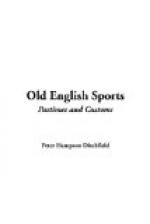When the Queen visited Kenilworth Castle, splendid pageants were performed in her honour. As she entered the castle the gigantic porter recited verses to greet her Majesty, gods and goddesses offered gifts and compliments on bended knee, and the Lady of the Lake, surrounded by Tritons and Nereids, came on a floating island to do homage to the peerless Elizabeth, and to welcome her to all the sport the castle could afford. For an account of the strange conduct of Orion and his dolphin upon this occasion, we refer our readers to Sir Walter Scott’s Kenilworth, and the lover of pageants will find much to interest him in Gascoigne’s Princely Progress. In many of the chief towns of England the members of the Guilds were obliged by their ordinances to have a pageant once every year, which was of a religious nature. The Guild of St. Mary at Beverley made a yearly representation of the Presentation of Christ in the Temple, one of their number being dressed as a queen to represent the Virgin, “having what may seem a son in her arms,” two others representing Joseph and Simeon, and two others going as angels carrying lights. The people of England seem always to have had a great fondness for shows and pageants.
CHAPTER XI.
NOVEMBER.
“The ploughman, though he
labour hard,
Yet on the holiday
Heigh trolollie, lollie loe.
No emperor so merrily
Doth pass his time away;
Then care away,
And wend along with me.”—Complete
Angler.
“The
curious preciseness,
And all pretended gravity
of those
That seek to banish hence
these harmless sports,
Have thrust away much ancient
honesty.”—IRVING’S Sketch
Book.
All-hallow Eve—“Soul Cakes”—Diving for Apples—The Fifth of November—Martinmas—Demands Joyous—Indoor Games.
The first of November is All Saints’ Day, and the eve of that day, called All-hallow Even, was the occasion of some very ancient and curious customs. It seems to have been observed more by the descendants of the Celts than by the Saxons; and Wales, Scotland, and Ireland were the homes of many of the popular superstitions connected with this festival. In Scotland the bonfires were set up in every village, and each member of a family would throw in a white stone marked with his name; and if that stone could not be found next morning, it was supposed that that person would die before the following All Saints’ Day. This foolish superstition may be classed with the other well-known superstition with regard to the sitting of thirteen people at one table, in which some are still foolish enough to believe.
All-hallow Even was supposed to be a great night for witches: possibly it was with the intention of guarding against their spells that the farmers used to carry blazing straw around their cornfields and stacks. It was the custom for the farmer to regale his men with seed cake on this night; and there were cakes called “Soul Mass Cakes,” or “Soul Cakes,” which were given to the poor. These were of triangular shape, and poor people in Staffordshire used to go a-souling, i.e. collecting these soul cakes, or anything else they could get.




